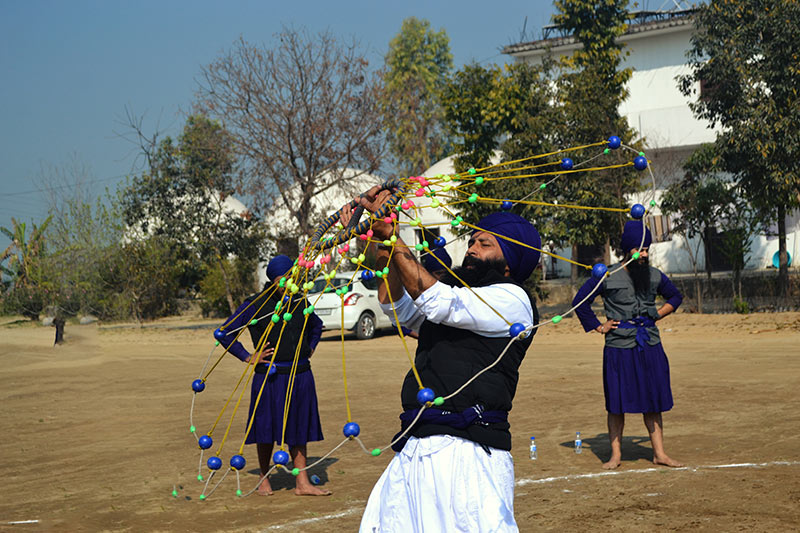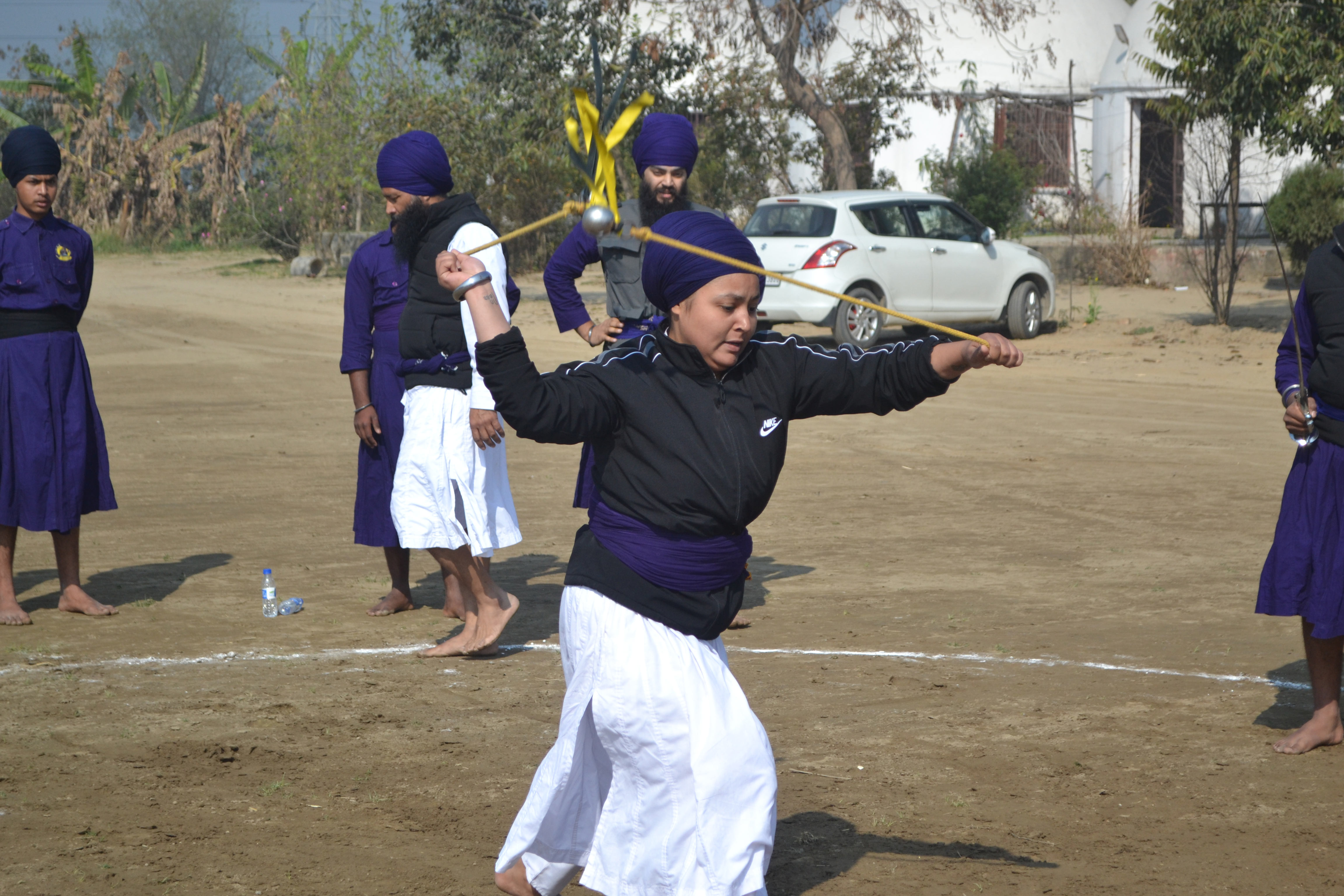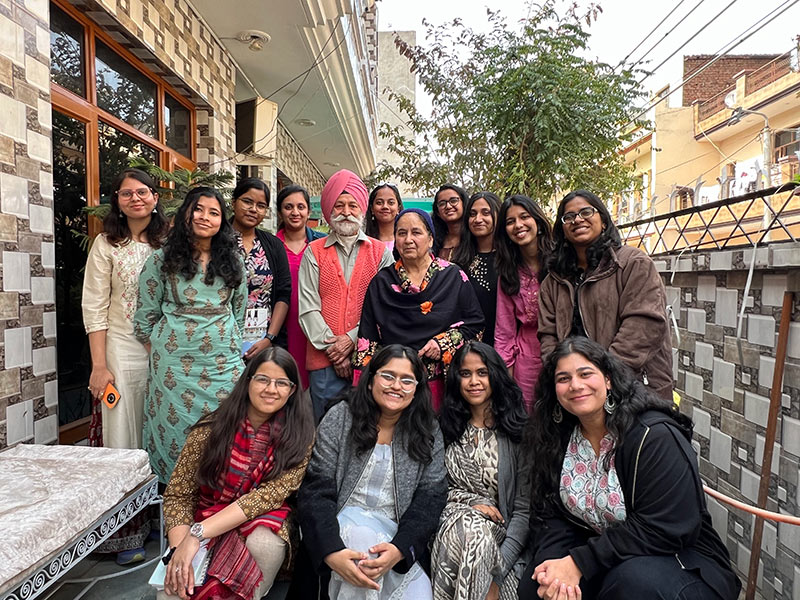VOICE OF FLAME
Gatka: A Weapon of Peace, the Sikh Traditional Martial Art - Anandpur Sahib, Punjab | Discover India Program
08 Oct 2024 | Author: Bandana Bindra |

Gatka: A Weapon of Peace, the Sikh Traditional Martial Art - Anandpur Sahib, Punjab | Discover India Program
Waheguru Ji Ka Khalsa, Waheguru Ji Ki Fateh
The Discover India Program is an opportunity for students to explore the rich cultural tapestry of India through the lens of research and inquiry. This program is for all second-year undergraduate students, where they conduct primary and secondary research under the guidance of a faculty mentor. This culminates in incredibly insightful and comprehensive research projects-extensive reports, fascinating documentaries, and engaging presentations of the respective research topics. These topics are often interdisciplinary and nuanced, which allows students to explore unique aspects of the country.
Awareness of Gatka, the Sikh Martial Art, is scarce in the general public. The birthplace of Gatka is in the Shivalik range's foothills, in the town of Anandpur Sahib. Gatka is about weapons, combat, discipline, self-defense, resilience, and honor. This is precisely why, as a part of the Discover India Program, my group chose to connect with a tradition that has shaped past generations and continues to motivate and strengthen the upcoming generations.
We got an opportunity to deeply engage with the local culture and immerse ourselves in the spiritual significance of the town. Visiting the various Gurudwaras, museums, and Gatka Academies expanded our understanding of the cultural practices of Anandpur Sahib. Also, it helped us connect with individuals passionate about preserving this lesser-known aspect of their heritage.
Coming across Gatka
The term "Gatka" derives from the Persian word Khutka, meaning a "leather-covered club used in fencing." This martial art was introduced by the 6th Guru, Guru Hargobind Singh, for self-defense and later popularized by the 10th Guru, Guru Gobind Singh, who established the Khalsa-a community of warriors dedicated to justice and protection of the innocent.
Existing literature on Gatka is limited and polarized. Some view Gatka as glamorous and exotic, while others criticize it as violent. Our research addresses gaps in this literature by analyzing Gatka's historical evolution, its impact on women's empowerment, and its sociological and psychological implications in Punjab.
Gatka is more than just weapons and combat; it embodies discipline, self-defense, resilience, and honor.
Studying Gatka: From Cultural Heritage to Self-Defense
Gatka evolved from traditional stick fighting used for self-defense into a sophisticated martial art during the 14th century. Despite facing challenges due to political turmoil, it underwent a revival in the 1920s and has since re-emerged in contemporary times. Gatka incorporates various combat techniques, including hand-to-hand combat, armed combat, and stick fighting, derived from the use of close-range weapons or Shastar.
Journey to Anandpur Sahib: The Cradle of Gatka
Anandpur Sahib, often referred to as the "City of Bliss," was where Guru Gobind Singh revitalized Gatka, transforming it into a powerful symbol of the Sikh community's resilience and spiritual strength. Our journey to Punjab took us through a range of terrains and across the scenic beauties that are a sight to behold. The planning for this trip started months in advance. We made sure to try and be extremely thorough, keeping in mind the minutest of details to ensure a smooth experience on-field. We reached out to Gatka players, coaches, academy heads, and any relevant government officials well in advance to inform them of our visit and potentially discuss an opportunity to interview them in person. It was heartwarming to receive the unconditional support and cooperation that we received from everyone there throughout the tenure of our research project.
Colonial Constraints and Gatka's Evolution
Following the annexation of Punjab, the British prohibited Sikh martial arts, including Gatka. After the First Anglo-Sikh War in 1846, efforts were made to establish the First British Sikh Army to reconcile the defeated Khalsa. Eventually, Gatka was modified to involve wooden training sticks to comply with British regulations. Throughout colonial rule, Gatka persisted, embraced by rural communities and preserved by figures like Sant Sipahi Eshar Singh and others, showcasing the Sikh community's dedication to preserving their cultural traditions through strategic adaptations during significant events.
The Structure and Philosophy of Gatka Gatka is a unique martial art that blends physical skill with spiritual devotion, rooted in the Sikh philosophy of Miri-Piri, which emphasizes the balance between temporal and spiritual power. Practitioners focus on controlled combat and precise techniques, beginning their training with prayers to reinforce the spiritual aspect of the art. The attire and weapons used, such as the kirpan and chakkar, hold deep symbolic meaning, reflecting the fusion of power and spirituality in the practice. This disciplined approach, regulated by the World Gatka Federation, underscores the cultural and religious significance of Gatka.
Gatka is a unique martial art that blends physical skill with spiritual devotion, rooted in the Sikh philosophy of Miri-Piri, which emphasizes the balance between temporal and spiritual power. Practitioners focus on controlled combat and precise techniques, beginning their training with prayers to reinforce the spiritual aspect of the art. The attire and weapons used, such as the kirpan and chakkar, hold deep symbolic meaning, reflecting the fusion of power and spirituality in the practice. This disciplined approach, regulated by the World Gatka Federation, underscores the cultural and religious significance of Gatka.
Miri Piri & Shastra Vidya
Miri-Piri and Shastra Vidya, rooted in Sikh philosophy, are essential aspects of Gatka, a traditional Sikh martial art. Miri-Piri, symbolized by the two swords carried by Guru Hargobind Singh, represents the unification of physical power (Miri) and spiritual strength (Piri). This fusion of Shakti (power) and Bhakti (spirituality) underscores the importance of using force to protect one's faith and defend the helpless. Gatka, as explained by Gurwinder Kaur, is not only a physical practice but also a spiritual discipline aimed at harmonizing the mind, body, and soul. Shastra Vidya, the ancient art of weaponry, involves mastering a variety of traditional Indian weapons and battle tactics. It embodies both the cultural and spiritual wisdom of martial arts, with Sikhism intertwining the ideologies of Shastar (weapon) and Shaastar (knowledge).
Gatka Techniques, Weaponry, and Uniforms
During our interviews and conversations, we realized that Gatka is a martial art focused on safety, fitness, and self-defense, emphasizing controlled combat, precise striking, blocking, and agile footwork like the Pantra. Players show respect to the art by performing an Ardas (prayer) and warm-up exercises before starting. The practice follows principles of self-restraint, such as 'Roko Aur Thoko' (wait and strike), where striking back is forbidden if the opponent does not retaliate within a specific time. The weapons used in Gatka include a variety of traditional arms, such as the Kirpan (curved sword), Chakkar (circular ring), Khandi (double-edged sword), and Dhaal (shield), among others. Each weapon has specific attributes and significance within the practice. All of this was very intriguing for us since we had the opportunity to witness it firsthand. We made a special note of the uniform. The Gatka uniform blends tradition with safety, as defined by the World Gatka Federation. It includes vests, shorts, singlets, lightweight shoes, gloves, and protective gear like knee and elbow guards. While turbans, eyeglasses, and chest guards are optional, players must adhere to uniform guidelines, with specific prohibitions on ornaments except for the Kara and Kangha.
Gatka: Bridging Tradition and Empowerment Beyond being a physical activity, Gatka serves as a bridge to cultural roots, fostering a deep sense of community and belonging among Sikhs. Traditionally male-dominated, Gatka is now evolving towards greater gender inclusivity. Inspired by figures like Mai Bhago, contemporary efforts are empowering women to actively participate in this art, making Gatka a symbol of empowerment and cultural pride. It was wonderful to see how it had adapted to the current times, as we met more and more people who introduced us to its nuances.
Beyond being a physical activity, Gatka serves as a bridge to cultural roots, fostering a deep sense of community and belonging among Sikhs. Traditionally male-dominated, Gatka is now evolving towards greater gender inclusivity. Inspired by figures like Mai Bhago, contemporary efforts are empowering women to actively participate in this art, making Gatka a symbol of empowerment and cultural pride. It was wonderful to see how it had adapted to the current times, as we met more and more people who introduced us to its nuances.
The Rise of Gatka as a Competitive Sport Gatka, originally a traditional Sikh martial art, has evolved into a recognized sport practiced in two sub-styles: Rasmi (traditional) and Khel (sport). Organizations like the World Gatka Federation and the Gatka Federation of India have been instrumental in its revival, standardization, and global recognition. Gatka has gained popularity beyond India, reaching countries like the United States, the United Kingdom, and Canada. As per our discussions, future goals include organizing international competitions like the Asia and World Gatka Championships, with aspirations for Olympic inclusion, as outlined in the World Gatka Federation's “Vision Document-2030.”
Our Experience on-field
Our time in Anandpur Sahib involved visits to multiple Gurudwaras and the Guru Tegh Bahadur Museum. We also met with Col. Inder Singh Thind (retd.), the author of ‘Gatka: The Traditional Sikh Martial Art’, and Mr. Harjeet Singh Grewal, the President of the National Gatka Association of India, where we understood more about the Martial Art form. We interviewed some locals and Veerjis (priests) in Shaheedi Bagh Gurudwara, Keshgarh Sahib Gurudwara, and Nada Sahib Gurudwara, which helped us gain a deeper understanding of the history and origins of Gatka.
One of the highlights of our DIP program was the visit to Sri Anandpur Sahib Khalsa Academy, Kapurthala. We took a two-hour journey at 4 am from Anandpur Sahib and were warmly welcomed by Mr. Inderpal Singh, the President of the Academy. The academy provides free healthcare, education, lodging, and food to children passionate about sports and academics. We got to interact with the coaches and witness an ongoing Gatka performance at the academy.
All in all, Punjab warmly welcomed us with delicious food and amazing hospitality while helping us make meaningful memories.
Reflections from the Journey: Exploring Gatka and the Spirit of Punjab  Visiting the gurudwaras and museums, interacting with practitioners, coaches, and other various stakeholders, and socializing with the locals revealed a profound dedication to upholding the spiritual and cultural essence of Gatka.
Visiting the gurudwaras and museums, interacting with practitioners, coaches, and other various stakeholders, and socializing with the locals revealed a profound dedication to upholding the spiritual and cultural essence of Gatka.
The pride and honor that the Sikh community carry in expressing their spiritual beliefs and practices was visibly seen as they held no stone overturned in their explanation of their religion to us. It was a humbling and gracious feeling to be included in learning about Sikhism as a whole.
This journey was more than just a research trip; it was an experience that broadened our horizons and deepened our understanding of Sikh culture and history.
Waheguru Ji Ka Khalsa, Waheguru Ji Ki Fateh
Team Members: Aabha Shouche, Archita Singh, Bandana Bindra, Diya Kiran, Gayatri Joshi, Ishika Mulage, Ishita Deshmukh, Kashish Agarwal, Mouli Rambhia, Prisha Khanna, Sahithi Chintala, Sharanya Ponugoti, Sharanya Vemaraju
(Author: Bandana Bindra, Undergraduate Student)






